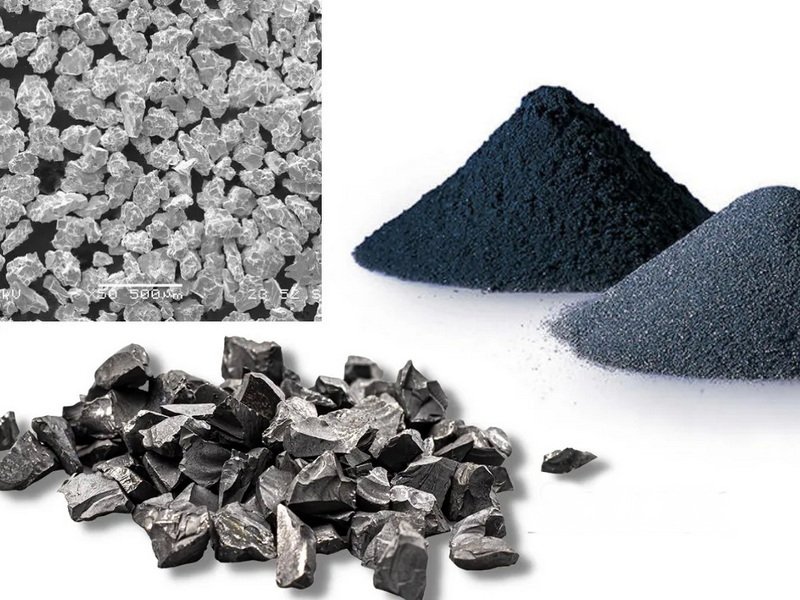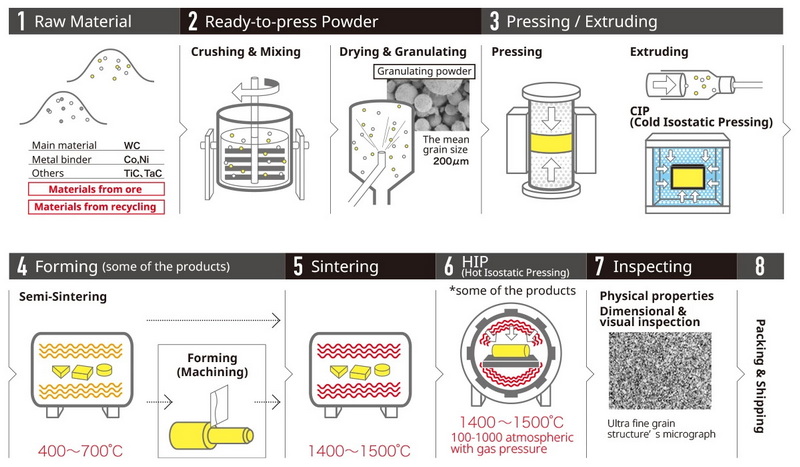Content Menu
● Introduction to Tungsten Carbide
>> Properties of Tungsten Carbide Powder
● Production Process of Tungsten Carbide Powder
● Applications of Tungsten Carbide Powder
>> Industrial Sector
>> Technology Sector
>> Aerospace and Automotive Sectors
● Challenges and Limitations
● Advanced Applications and Future Developments
>> Environmental Considerations
>> Economic Impact
● Conclusion
● Frequently Asked Questions
>> 1. What is the primary use of tungsten carbide powder?
>> 2. How is tungsten carbide powder produced?
>> 3. What are the key properties of tungsten carbide powder?
>> 4. What are some common applications of tungsten carbide powder beyond industrial uses?
>> 5. What safety precautions should be taken when handling tungsten carbide powder?
● Citations:
Tungsten carbide powder is a high-performance material renowned for its exceptional hardness and wear resistance, making it indispensable in various industrial applications. This article delves into the production process of tungsten carbide powder, its properties, and applications, providing a comprehensive overview of this versatile material.

Introduction to Tungsten Carbide
Tungsten carbide is composed of tungsten and carbon atoms bonded in a crystalline structure, typically following the stoichiometric ratio of WC. Its hardness is second only to diamond among industrial materials, and it maintains its properties at high temperatures, making it ideal for cutting tools, wear-resistant components, and high-performance coatings.
Properties of Tungsten Carbide Powder
- Hardness and Wear Resistance: Tungsten carbide powder offers exceptional hardness and wear resistance, making it suitable for applications requiring high durability.
- Thermal Stability: It exhibits high thermal stability, maintaining its properties across a wide temperature range.
- Chemical Inertness: The material is chemically inert, providing excellent corrosion resistance.
Production Process of Tungsten Carbide Powder
The production of tungsten carbide powder involves several key steps:
1.Material Mixing:
Tungsten powder is mixed with carbon black in a ball mill for 2-4 hours to ensure uniformity. This step is crucial as uneven mixing can lead to stratification and unreacted material cores in the final product.
A[Raw Materials] --> B[Ball Mill]
B --> C[Mixed Powder]
C --> D[Carburization]
D --> E[Tungsten Carbide Powder]
2. Carburization:
The mixed powder undergoes carburization in a graphite carbon tube furnace. The temperature and time depend on the desired particle size, typically ranging from 1300°C to 1600°C for 1-2 hours.
A[Mixed Powder] --> B[Graphite Furnace]
B --> C[Carburization at 1300-1600°C]
C --> D[Tungsten Carbide Formation]
3. Ball Milling and Sieving:
After carburization, the tungsten carbide powder is further processed in a ball mill to achieve uniform particle sizes. The powder is then sieved to separate fine, medium, and coarse particles.
A[Tungsten Carbide Powder] --> B[Ball Mill]
B --> C[Uniform Particle Size]
C --> D[Sieving]
D --> E[Fine, Medium, Coarse Particles]
4. Sintering:
The final step involves sintering the blended powder into a desired shape. This process involves heating the compacted powder at around 1500°C, causing the particles to fuse and form a dense cemented carbide body.
A[Blended Powder] --> B[Compaction]
B --> C[Sintering at 1500°C]
C --> D[Cemented Carbide Body]

Applications of Tungsten Carbide Powder
Tungsten carbide powder is widely used in various industries due to its exceptional properties:
- Cutting Tools: It is used in manufacturing high-speed cutting tools for metalworking, mining, and drilling operations.
- Wear-Resistant Components: The material is ideal for producing wear-resistant parts in aerospace, automotive, and energy sectors.
- High-Performance Coatings: Tungsten carbide powder is applied as protective coatings through thermal spray processes to enhance component durability.
Industrial Sector
- Manufacturing: Used in precision machining operations for extended tool life and superior surface finishes.
- Mining: Utilized in drilling equipment and crushing components to extend equipment life.
Technology Sector
- Semiconductor Industry: Employed in high-precision tools for circuit board drilling and electronic component manufacturing.
- Electrical Components: Valued for producing specialized electrical contacts and switches due to its electrical conductivity and wear performance.
Aerospace and Automotive Sectors
- Aerospace: Used in specialized coating applications for engine components and landing gear systems.
- Automotive: Applied in the production of abrasion-resistant components and high-performance engine parts.
Challenges and Limitations
While tungsten carbide powder offers numerous benefits, it also presents several challenges:
- High Density: May impact weight-sensitive applications.
- Complex Processing: Requires precise parameter control and specialized equipment.
- Safety Concerns: Potential risks from fine particle dust exposure necessitate proper handling practices.
Advanced Applications and Future Developments
In recent years, tungsten carbide has been explored for emerging applications:
- Fuel Cells: Tungsten carbide is being researched as a potential catalyst support in fuel cells due to its high surface area and stability.
- Biomedical Applications: Its biocompatibility and wear resistance make it suitable for medical implants and surgical instruments.
- Nanotechnology: Research into nanostructured tungsten carbide aims to enhance its mechanical properties further, opening up new possibilities in advanced materials science.
Environmental Considerations
The production and disposal of tungsten carbide powder must be managed with environmental considerations in mind. Recycling and reusing tungsten carbide components can significantly reduce waste and conserve resources.
Economic Impact
The demand for tungsten carbide powder is influenced by global economic trends, particularly in industries like manufacturing and aerospace. Fluctuations in raw material prices and geopolitical factors can impact production costs and market availability.
Conclusion
Tungsten carbide powder is a versatile material with exceptional hardness and wear resistance, making it crucial in various industrial applications. Understanding its production process and properties is essential for optimizing its use in cutting tools, wear-resistant components, and high-performance coatings. Despite its advantages, tungsten carbide powder also poses challenges related to processing complexity and safety considerations. As technology advances, new applications and innovations are expected to further expand its utility.

Frequently Asked Questions
1. What is the primary use of tungsten carbide powder?
- Tungsten carbide powder is primarily used as a raw material for cemented carbide, which is utilized in manufacturing cutting tools, wear-resistant components, and high-performance coatings.
2. How is tungsten carbide powder produced?
- The production involves mixing tungsten powder with carbon black, followed by carburization in a graphite furnace, ball milling, and sieving to achieve uniform particle sizes.
3. What are the key properties of tungsten carbide powder?
- It exhibits exceptional hardness, wear resistance, thermal stability, and chemical inertness, making it ideal for high-performance applications.
4. What are some common applications of tungsten carbide powder beyond industrial uses?
- Beyond industrial applications, tungsten carbide powder is used in aerospace, automotive, energy sectors, and emerging technologies like fuel cell components.
5. What safety precautions should be taken when handling tungsten carbide powder?
- Handling tungsten carbide powder requires proper safety measures due to potential risks from fine particle dust exposure. Specialized equipment and training are recommended.
Citations:
[1] https://heegermaterials.com/blog/90_how-is-tungsten-carbide-made-.html
[2] https://www.linde-amt.com/resource-library/articles/tungsten-carbide-powder
[3] https://www.allied-material.co.jp/en/techinfo/tungsten_carbide/use.html
[4] https://blog.csdn.net/qq_34917728/article/details/125122327
[5] https://repository.up.ac.za/bitstream/handle/2263/24896/03chapter3.pdf?sequence=4
[6] http://tungsten-powder.com/what-are-applications-of-tungsten-carbide-powder.html
[7] https://eurobalt.net/blog/2022/03/28/all-the-applications-of-tungsten-carbide/
[8] https://blogs.rsc.org/china/category/uncategorized/?doing_wp_cron=1721346583.1865599155426025390625
[9] http://www.tungsten-powder.com/Tungsten-Carbide-Powder-Process.html
[10] https://www.nanotrun.com/article/cemented-carbide-materials-tungsten-carbide-powder-i00426i1.html
[11] https://www.allied-material.co.jp/en/techinfo/tungsten_carbide/process.html
















